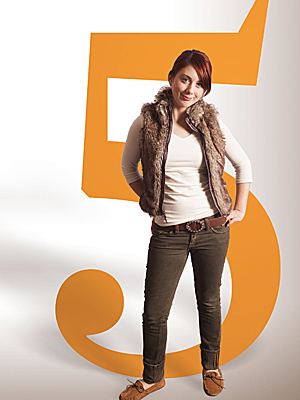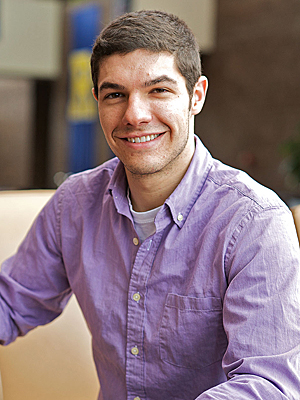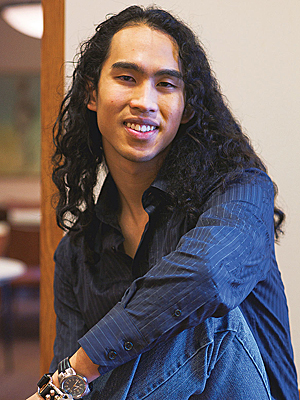Features
Richard Berman ’88 was facing hefty requirements for his molecular genetics major as he planned his junior year at Rochester. Now a Philadelphia-area dentist, Berman wanted to study abroad and pursue courses in literature and the arts.
Erica Kaminski ’09
Cherry Hill, N.J. Major: Neuroscience
Take Five Program: “Exploring Quantum Mechanics from a Mathematical, Historical, and Philosophical Perspective”

Erica Kaminski is the only Take Five scholar ever to propose a project on quantum mechanics. But she’s approaching it in an unusual way.
“It all began back in first-semester calculus,” she says. “I fell in love with mathematics. My professor, Douglas Haessig, became my mentor and role model. He introduced me to a field of theoretical science that immediately captivated me: relativity.”
As Kaminski, a neuroscience major, became increasingly drawn to physics, she took the course The Milky Way Galaxy, taught by Adam Frank, a professor of physics and astronomy. There, already open to the “bizarre” aspects of relativity, “I began to wonder about the ‘weird’ of the microscopic world.”
After Frank’s lecture on quantum mechanics, she began seriously considering a Take Five related to physics.
Because Take Five requires an interdisciplinary course program, students must think creatively and multidimensionally about their projects. To grasp quantum mechanics, Kaminski needed additional courses in math and physics. But she also wanted to understand the path to its discovery, as well as the broader implications of this most counterintuitive physical reality. So she crafted a program consisting of courses in the history of science and metaphysics as well as math and physics.
“Take Five has given me closure to my college years in such a meaningful and symbolic way,” she says. “It’s been the culmination of all the knowledge I have learned, not just about science, but also about learning, period.”
In the fall of his junior year, he squeezed in a semester in London, combining major requirements with courses in literature. “I went to the Royal Shakespeare Company every other weekend,” he recalls with relish.
When he returned in 1986 for the spring semester, however, he was greeted with two surprises. First, he discovered that two courses required for his major would not be taught until after his anticipated graduation. But he also found out that students had been invited to apply to a new program offering a tuition-free fifth year for students who wanted more time to explore their intellectual interests.
That March, Berman became one of Rochester’s first Take Five scholars.
“I did it backwards,” says Berman of his “retroactive” application. But he notes, “I took all these other wonderful classes that I wouldn’t have had the opportunity to take.”
Officially celebrating its 20th anniversary last fall—and soon to accept its 1,000th student—few undergraduate programs define the Rochester experience quite like Take Five. Officially named the Take Five Scholars Program, the program offers undergraduates the opportunity to spend up to an additional year on campus, tuition-free, to pursue their intellectual interests outside their major field.
Since its founding, Take Five has been recognized as a unique program in higher education. Shortly after its launch, the New York Times profiled the initiative, declaring, “One of the more innovative liberal arts programs in the country is taking place on this campus of red brick Greek Revival buildings, sprawled along the banks of the Genesee River.”
Sam Lehman ’09
Cumberland, Maine Major: Religion
Take Five Program: “The Manifestations of Discontent in Latin America”

Among the original features of the Take Five Scholars Program that still play a role in its success is that a Take Five Scholar, in his or her fifth year, serves on the board that decides who is admitted to the program.
For 2008–09, the student representative is Sam Lehman. Lehman must read and rate between 70 and 90 applications in the fall semester, and 30 to 40 more in the spring.
It’s a lot of work for any student, but particularly for Lehman, whose multiple roles in student government earned him the 2008 Rob Rouzer Award for Excellence in Student Government Leadership. Nonetheless, having a student representative is important to the program, Lehman says.
“Students are hooked into the reputation of specific courses and fields in a way that professors sometimes aren’t,” he says. “So a student looks at transcripts and course selections differently.”
Lehman chose his major in religion after taking courses with “three fantastic professors with three completely different perspectives on three totally different subjects”: Ann Meredith, who specializes in early Christianity; Emil Homerin, a professor of Islamic and Arabic studies; and Curt Cadorette, an expert on Catholicism whose course on liberation theology inspired Lehman’s Take Five program on the politics and society of Latin America.
Lehman says his program, consisting of courses in history, political science, and anthropology, will help him explore “what political and economic developments created class stratification” in Latin American countries, and “how people who can’t use traditional avenues express discontent.”
And although the program has evolved over the years—for example, Berman’s “retroactive” application would no longer be permitted—its defining feature has remained unchanged: Take Five is an opportunity for students to take advantage of additional time to pursue learning for its own sake.
Suzanne Jagel O’Brien ’59, the associate dean of undergraduate studies in the College, has overseen the program’s administration since shortly after its inception. She also serves on the Take Five Review Board, a six-member panel that includes four faculty members and one Take Five Scholar.
“One thing that continues to amaze me,” she says, “is how creative these students are.”
Creativity is a key element of the program. More than a chance to indulge in a smattering of courses across departments or pursue an additional major in an area of special interest, Take Five requires students to propose a coherent, yet interdisciplinary, program of courses, and to be able to articulate their intellectual goals.
Nicholas Huang ’11
Butte, Mont. Majors: Biomedical Engineering and Music
Take Five Program: “The Intricate Puzzle of the Mind”

Nicholas Huang started his studies as a dual degree student at both the School of Engineering and Applied Sciences and the Eastman School of Music. He has since decided to be a “mere” double degree student in biomedical engineering and music, both in the College. Completing both degrees, however, still required course “overloads” across many semesters—especially for Huang, who wanted room to explore even more areas of study.
With interests that also include Chinese language and culture and Medieval Europe, Huang regularly signs up for one or two courses more than what is advised for even especially strong students.
But it will still take him a fifth year to pursue what he considers the missing half of his education in the biological sciences. While Huang’s work in biochemistry and cell and tissue engineering has taught him a great deal about how synapses fire and neurons interconnect, he has learned less about the more abstract state—consciousness—that Huang believes explains “how we think.”
“The mind is a truly fascinating thing,” he says. “How we think more than anything in our physical make-up is what makes each of us unique.”
Huang, a junior, is just getting started on his program, which combines courses in perception, cognition, and philosophy.
“There are enough interesting courses that I could spend two or three years studying without finishing them all.”
For example, in the current Take Five “class,” Robert Halm ’09, a mechanical engineering major from Amherst, N.Y., has outlined a selection of courses in English, linguistics, history, and Latin for a program he calls “Myth and Its Evolution in Early Medieval Northern and Western Europe.”
And Rosemary Shojaie ’09, a biology major from Rochester, has put together a set of courses in history, art history, and political science to pursue “Addressing Social Issues Through Art in Post-Revolutionary Iran.”
To complete the Take Five program, students are expected to work closely with faculty members, often arranging one-on-one, independent tutorials with professors.
Emil Homerin, a professor in the Department of Religion and Classics, says such efforts “tie together the strands of the student’s program.”
Also a member of the program’s review board, Homerin says Take Five students add enormously to campus intellectual discussions.
“These students bring so much to the classroom,” says Homerin. “You want to have these students around.”
Such students include Ashanti O’Steen ’09, a biology major from Buffalo. A student in the University’s Ronald E. McNair Post-Baccalaureate Achievement Program, which is designed to prepare students for doctoral studies, O’Steen has presented her work at the National Conference on Undergraduate Research. She’s focusing her Take Five program on “A Pattern of Poverty in Latin America,” which has allowed her to combine studies in economics, history, and political science as well as spend a semester studying in Buenos Aires.
Another example is Erik Tobiason ’08, a physics major from Amherst, Mass. A founder of the “Books for Baghdad” drive on campus that sent hundreds of textbooks from Rochester students to counterparts at the University of Baghdad, Tobiason has settled in to life at the Community Learning Center, an on-campus special interest housing program in which students from a variety of backgrounds host cultural programs and participate in community service activities around the area.
Faculty members first came up with the idea for Take Five as part of a University-wide conversation about the institution’s goals. Shortly after his arrival in the summer of 1984, then University president Dennis O’Brien (no relation to Suzanne O’Brien) established a Committee on University Goals composed of faculty members and administrators.
Among the committee’s findings was that undergraduates were not benefiting adequately from the University’s assets. The late Ann Fehn, a professor of German, and Sidney Shapiro, now a professor emeritus of electrical and computer engineering, argued that for some students, particularly those in engineering or other bachelor of science programs, the requirements for a major, when added to other academic requirements, left no space for exploration.
Persuaded by the argument, the committee included in its final report a recommendation for a program that would offer a tuition-free fifth year for a select number of undergraduates to pursue courses for intellectual enrichment.
In fall 1985, Ruth Freeman, then an associate provost and University dean, announced the new “Take Five” program, and in March 1986, she presented the first applications for up to 20 students to become Take Five Scholars.
In 1992, the limit on the number of students was lifted, and the program’s original focus on students pursuing bachelor of science degrees was broadened to allow more students from a wider range of degree programs to participate.
In addition, a new review board was charged with evaluating applications to ensure that each student presents a compelling case for acceptance into Take Five. Applicants were required to develop their proposals in consultation with a faculty member who agrees to serve as the student’s program advisor. And to help students understand and conform to the rules of Take Five, a professional academic advisor was appointed in the College Center for Academic Support.
The program remains popular with students. In a typical year, as many as 90 students apply for the fall semester, and as many as 40 more in the spring. Because students who are rejected are allowed to apply a second time, in the end, roughly half the students who seek a Take Five scholarship are admitted. In December 2008, for example, the program’s board admitted 37 additional students.
Jonathan Burdick, dean of admissions and financial aid, says interest in the program often begins before students set foot on campus.
“Many prospective students find Take Five attractive—both those who can already think of a specific way they’d use their extra year, and an even larger number who just love the idea and come to understand the University better because of it,” he says.
Renato Perucchio, a professor of mechanical engineering and longtime member of the program’s board, says he would like to see more engineering students participate.
“It’s an outstanding opportunity for engineers to broaden their horizons,” he says. “Unfortunately, engineering programs leave very little time for students to develop an interest, which is something that has been proven to me over and over.”
Part of the dilemma, Perucchio says, is that increasingly engineering students are learning that they need to complete a master’s degree, which causes them to think twice about extending their schooling for another year.
Lisa Norwood ’86, ’95W (MS), an assistant dean for engineering, says she’s also noticed that fewer engineers than arts and sciences students take advantage of Take Five.
But, she adds, “For those who choose to take advantage of it, it’s life-changing.”
That’s been the case for Nicholas Huang ’11, a Take Five Scholar from Butte, Mont., whose project is called “The Intricate Puzzle of the Mind.”
Huang says he doesn’t ever intend to stop learning, but he appreciates having the chance to explore while still a student.
“Take Five is one the best opportunities I will ever have to learn in-depth about something new.”r
Karen McCally ’02 (PhD) was the academic advisor for Take Five from 2002 to 2004.
